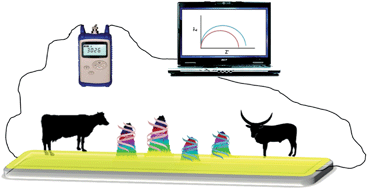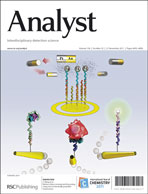Our studies show that electrochemical impedance spectroscopy (EIS) and scanning electrochemical microscopy (SECM) of films of ds-DNA on gold allow us to distinguish between mitochondrial DNA fragments of the cytochrome c1 oxidase (mt-Cox1) of three related species of the subfamily ‘Bovinae’ (Bos taurus, Bison bison, and Bison bonasus). In EIS, a perfectly matched DNA gives rise to a considerably larger charge transfer resistance Rct compared to mismatched pairings. Differences in charge transfer resistance, ΔRct, before and after the addition of Zn2+ ions provide an additional tool for identification. In addition, all ds-DNA films were studied by SECM and their kinetic parameters were determined. Perfectly matched ds-DNAs are readily distinguished from mismatched duplexes by their lower rate constants. Our system can be used multiple times by dehybridization and rehybridization of capture strands up to the 250 pmole level.
You have access to this article
 Please wait while we load your content...
Something went wrong. Try again?
Please wait while we load your content...
Something went wrong. Try again?


 Please wait while we load your content...
Please wait while we load your content...